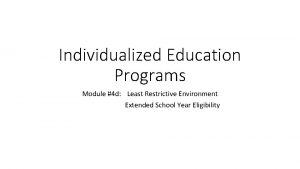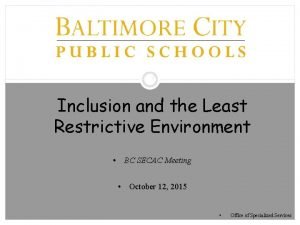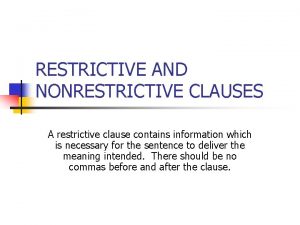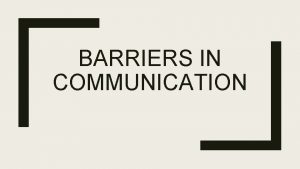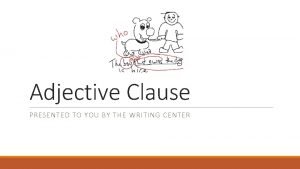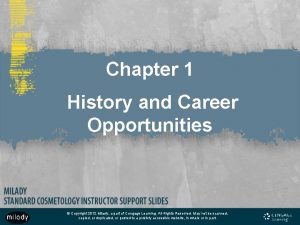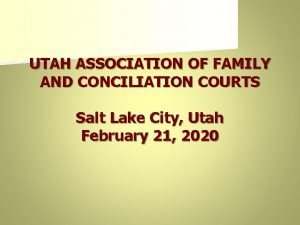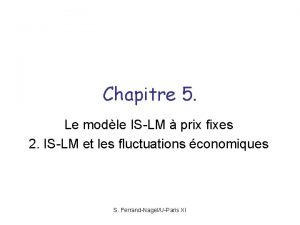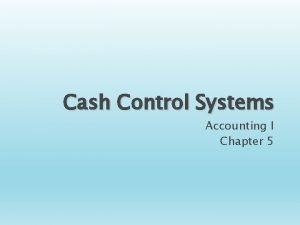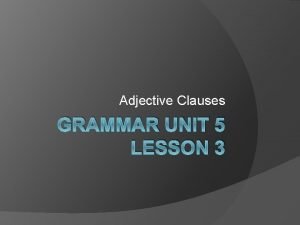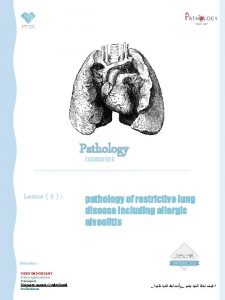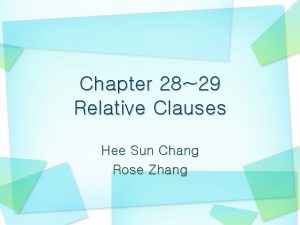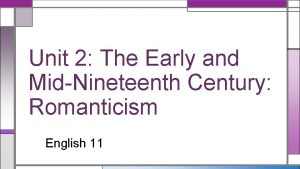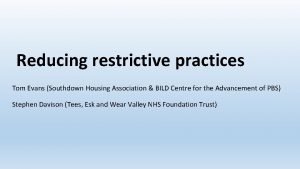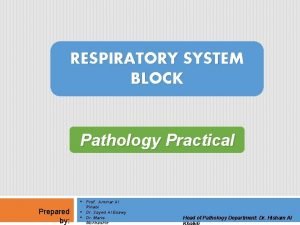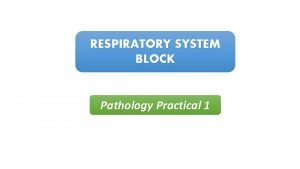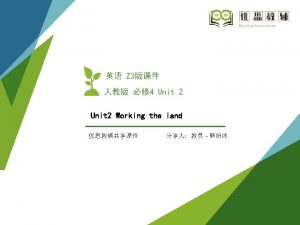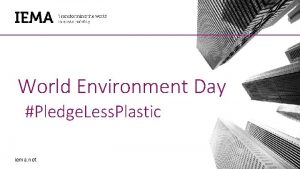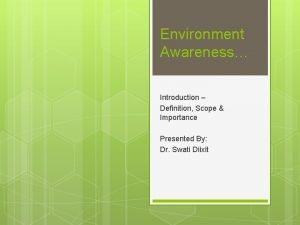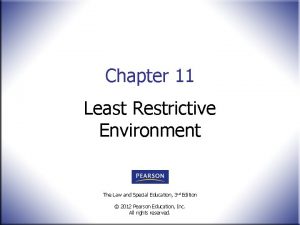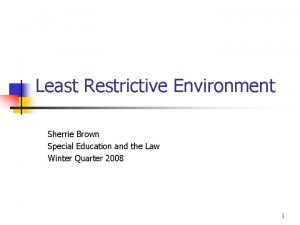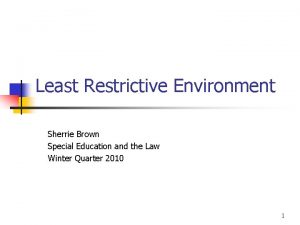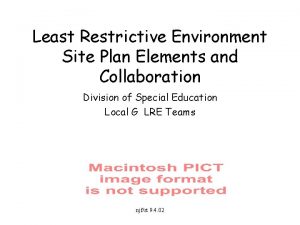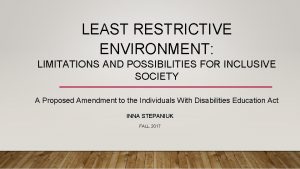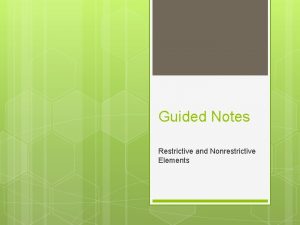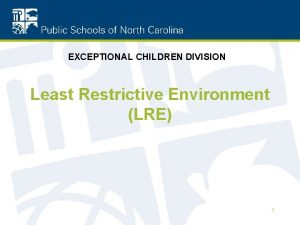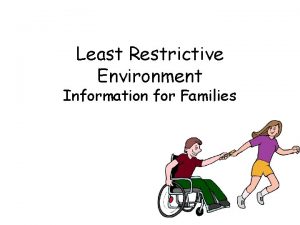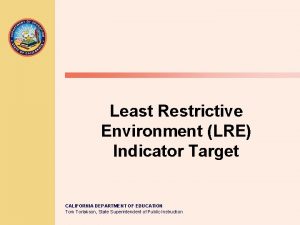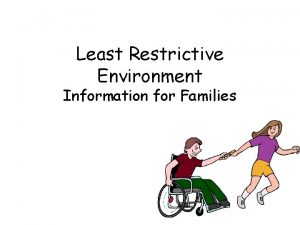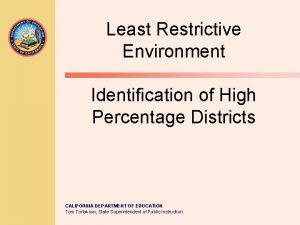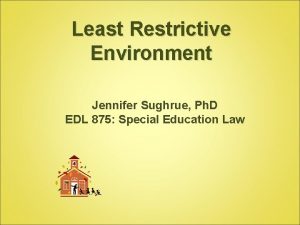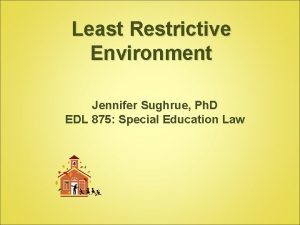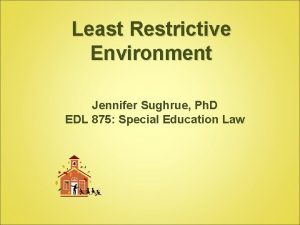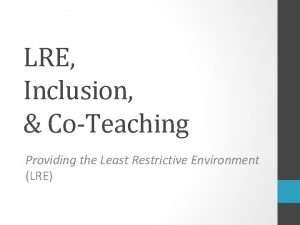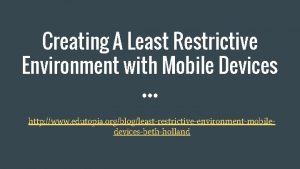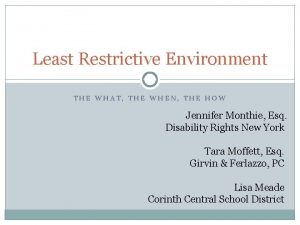Least Restrictive Environment A World of Options and




































- Slides: 36

Least Restrictive Environment: A World of Options and Opportunities n Training provided by the Connecticut State Department of Education in cooperation with: • Connecticut Parent Advocacy Center • Connecticut Coalition for Inclusive Education • University of Connecticut Center for Developmental Disabilities

Agenda No Child Left Behind (NCLB) n The Individuals with Disabilities Education Act (IDEA ‘ 04) n The settlement agreement in the “P. J. case” n Q&A n

No Child Left Behind Signed into law January 8, 2002 n Improve outcomes for ALL children n Close the achievement gap between children with and without disabilities n

No Child Left Behind Accountability n Doing what works n Highly qualified teachers n Parent involvement Choice n

Individuals with Disabilities Education Act (IDEA ‘ 04) n 1975—Education of All Handicapped Children Act (EHA) n Reauthorized every five years n Provides for a free appropriate public education or FAPE for students with disabilities n Impact of reauthorization (2004)

IDEA ’ 04 Changes n Aligns closely with No Child Left Behind (NCLB) n Evaluation Procedures Revised n IEP Provisions Changed n Emphasis on Universal Design n Parent Participation Modified

Individualized Education Program (IEP) n The foundation of IDEA n Created for each child according to his or her individual needs n Details the special education and related services that the district will provide to meet those needs

IEP: Planning before placement 1. Evaluate 2. Develop IEP 3. Placement

Placement is individually determined n Based on the child’s IEP n Determined by the child’s Planning and Placement Team (PPT) n Determined at least annually n Is as close as possible to the child’s home school

Placement in the Least Restrictive Environment or LRE “…to the maximum extent appropriate children with disabilities… are educated with children who are not disabled…”

LRE continued… n “… removal of children with disabilities from the regular education environment occurs only when the nature or severity of the disability is such that education in regular classes with the use of supplementary aids and services cannot be achieved satisfactorily. ”

LRE continued … n If it is not possible to educate a child successfully in a regular education classroom with the use of supplementary aids and services, then team must consider more restrictive alternatives.

Placement in the Least Restrictive Environment n Regular classroom placement is the first option the team must consider n Access to the general education curriculum is as important as placement in a classroom

Supplementary Aids and Services “… aids, services, and other supports that are provided in regular education classes or other education related settings…

Supplementary Aids and Services “to enable children with disabilities to be educated with non disabled children to the maximum extent appropriate. ”

Supplementary aids and services can include changes in: n n n Environment Instructional strategies Social or behavioral support Staff support Assessment

Environmental supports n Special seating n Study carrel n Providing space for movement or breaks n Providing help to maintain an uncluttered space

Instructional modifications n Teaching to a child’s learning style n Providing one-to-one instruction n Providing differentiated instruction n Providing hands-on activities n Using technology to support instruction

Behavioral supports n n n Rest breaks Teaching child how to make friends Functional behavioral analysis Positive behavioral intervention plan Teaching independence

Staff supports Enhanced staffing Co-taught classroom Small group instruction n Providing staff training n Collaboration time n Use of paraprofessional staff n n n

Testing accommodations n Allowing answers to be dictated n Allowing additional time n Reading test to student n Accepting short answers n Highlighting key directions

School wide supports n Administrative leadership n All staff professional development n Early intervention n School climate n Positive behavioral supports n Opportunities for collaboration n Family involvement

IDEA provides for services in non-academic settings n “Each public agency shall take steps to provide nonacademic and extracurricular services and activities in the manner necessary to afford children with disabilities an equal opportunity for participation in those services and activities. ”

Provisions of IDEA continued… n In determining the education placement of a child with a disability … “unless the IEP of a child with a disability requires some other arrangement, the child is educated in the school that he or she would attend if nondisabled. ”

P. J. et al v. State of CT et al n Federal class action lawsuit filed in 1991 – settled in May, 2002 n Class membership: school age students with mental retardation or intellectual disabilities who are not educated in regular education classrooms

5 Goals of the Settlement Agreement n Regular class placement n Time with non disabled peers n Home school placement n Extracurricular activities n Disparate identification

Goals of the Settlement Agreement Increase in number of students with ID in regular class placement - 80% or more of school day n Reduction in disparate identification based on race, ethnicity, gender n

Increase in amount of time students with ID spend with non-disabled peers… n n n n Academic classes Recess, lunch Specials Field trips Band, chorus After school activities Community based training

Goals, continued … Increase in percent of students with ID who attend their home school. n Increase in percent of students with ID who participate in extracurricular activities n

How will these goals be addressed? n Parents • training • information • support • involvement on district and school based teams • parent to parent support

Addressing the Goals n School • • • Districts Monitoring of data on all five goals for all school districts Focused monitoring of LRE data for all school districts Action plans for improvement in all districts Identification of districts most in need of training and technical assistance Identification of spot light programs and success stories in CT

Addressing the Goals n n n State wide training initiative by Special Education Resource Center (SERC) Facilitation of the School Based Practices Profile in districts Coaches Academy and Student Response Team Expert Advisory Panel - EAP Involvement of plaintiffs in planning, implementing and evaluating strategies Annual reporting to the court and plaintiffs for five years

What does research tell us about inclusive education? Placement in inclusive programs led to academic gains for students with disabilities, including improved performance on standardized tests, mastery of IEP goals, grades, ontask behavior and motivation to learn (National Center for Education Restructuring and Inclusion, 1995).

What does research tell us about inclusive education? Students with ID educated in inclusive classes test higher on literacy measures than students educated in separate special education classes (Buckley, Bird, Sacks, & Archer, 2000).

What does research tell us about inclusive education? Placement in inclusive classrooms does not interfere with the academic performance of students without disabilities with respect to the amount of allocated time and engaged instructional time, the rate of interruption to planned activities and students’ achievement on test scores and report card grades (York, Vandercook, Mac. Donald, Heise-Neff, and Caughey, 1992).

Where can I learn more? n n n n State Department of Education Special Education Resource Center CT Parent Advocacy Center - CPAC Arc CT CT Coalition for Inclusive Education DMR State and national websites
 Esy justification statement
Esy justification statement Least restrictive environment examples
Least restrictive environment examples Define least restrictive environment
Define least restrictive environment Restrictive clause examples
Restrictive clause examples Factors causing language barriers
Factors causing language barriers Adjective dependent clause
Adjective dependent clause Restrictive nonrestrictive clauses
Restrictive nonrestrictive clauses Restrictive and nonrestrictive adjective clauses
Restrictive and nonrestrictive adjective clauses During which austere and restrictive period
During which austere and restrictive period Caplan syndrome
Caplan syndrome Difference between obstructive and restrictive lung disease
Difference between obstructive and restrictive lung disease Environment of business finance
Environment of business finance The least offensive play in the whole darn world
The least offensive play in the whole darn world Family facilitator guide utah
Family facilitator guide utah Obstructive vs restrictive lung disease
Obstructive vs restrictive lung disease Politique monetaire restrictive
Politique monetaire restrictive Uip
Uip Obstructive vs restrictive
Obstructive vs restrictive Politique monetaire restrictive
Politique monetaire restrictive Part 5 preparing a check stub and check
Part 5 preparing a check stub and check Non restrictive clause
Non restrictive clause Restrictive lung disease
Restrictive lung disease Pft
Pft Restrictive lung disease
Restrictive lung disease Relative pronouns german
Relative pronouns german Whats a relative pronoun
Whats a relative pronoun Which two sentences contain a restrictive clause?
Which two sentences contain a restrictive clause? Terminology relating to restrictive practice
Terminology relating to restrictive practice Pneumonia
Pneumonia Alveoli
Alveoli World environment health day
World environment health day Notice world environment day
Notice world environment day Iema net
Iema net Tree poem in english
Tree poem in english World environment day 2021
World environment day 2021 Ap world history chapter 25 africa and the atlantic world
Ap world history chapter 25 africa and the atlantic world The changing world output and world trade picture
The changing world output and world trade picture
